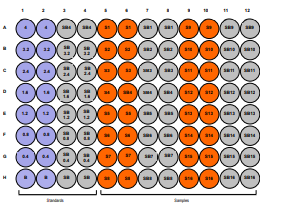Rat Urinary Protein Assay Standard
- SKU:
- 445-90401
- Size:
- 4 mg/ml x 1.5 ml
- Shipping:
- Gel Packs
- Storage:
- -20 C
Description
Rat Urinary Protein Assay Standard - Cat Number: 90401 From Chondrex.
Research Field: Nephritis
Clonality: N/A
Cross-Reactivity:
Host Origin: N/A
Applications: N/A
Isotype: N/A
Detection Range: N/A
Sample Type: N/A
Concentration: N/A
Immunogen:
PRODUCT SPECIFICATIONS
DESCRIPTION: Assay kit to evaluate urinary protein concentration
FORMAT: 96-well ELISA Plate with removeable strips
ASSAY TYPE: Turbidity Assay
ASSAY TIME: 10 minutes
STANDARD RANGE: 4 mg/ml to 0.4 mg/ml
NUMBER OF SAMPLES: Up to 16 (duplicate) samples/plate
SAMPLE TYPES: Urine
RECOMMENDED SAMPLE DILUTIONS: 1:2 (at least)
CHROMOGEN: N/A (read at 450 nm)
STORAGE: -20°C for 12 months
VALIDATION DATA: N/A
INTRODUCTION
The turbidity assay method (1) has been widely used to determine urinary protein levels in human specimens because it is accurate, easy, and economical. However, urine volume collected from rats varies from 0.1 ml to 20 ml during a 16-hour collection period, thus the volume is occasionally insufficient for current assay methods. In addition, turbidity (OD 450 nm) readings of individual test tubes using a spectrophotometer may be cumbersome. Chondrex, Inc.’s Rat Urinary Protein Assay Kit (Cat # 9040) uses the turbidity method in 96-well plates, offering a solution for assaying a large number of rat urine samples.
Protein concentrations in urine samples can be determined by turbidity or Bradford assay methods (2). The turbidity assay method which utilizes 3% sulfosalicylic acid is more convenient than the Bradford assay method for assaying a large number of samples because of the wide range of the dose response curve (Ex: 0.4 to 4 mg/ml) and the stable turbidity. Regardless of the assay method used, bovine serum albumin (BSA) cannot be used as a standard. For example, in the turbidity assay, the dose response curve generated by BSA significantly differs from that of serum proteins. In the Bradford assay, OD value of globulins is only 70% that of BSA (3). Therefore, a standard protein solution prepared from normal rat serum is ideal for assaying urinary protein levels instead of using BSA.
NOTE: The Bradford assay method requires two separate regression curves for assaying protein concentration, from 0.05 to 0.6 mg/ml and from 0.5 to 1.5 mg/ml. Because the protein concentration in rat urine can vary from 0.1 mg/ml to 50 mg/ml depending upon the progress of
nephritis, various dilutions of individual samples are required.
KIT COMPONENTS

URINE COLLECTION PROTOCOL
Collect urine from 5 pm to 9 am every other day with metabolic cages. Measure the urine volume and centrifuge to remove insoluble materials.
Keep the supernatant in a refrigerator for short-term storage and at –20°C for long-term storage.
PLATE LAYOUT
The assay should be performed in duplicate for both standards and samples. Because urine samples and even the standard may be colored due to hemoglobin contamination, it is important to determine the individual background values and subtract them from the turbidity values in sample wells. Therefore, columns 3-4, 7-8, and 11-12 are used as blank wells.

NOTES BEFORE USING ASSAY
NOTE 1: It is recommended that the standard and samples be run in duplicate.
NOTE 2: This kit contains animal components from non-infectious animals and should be treated as potential biohazards in use and for disposal.






